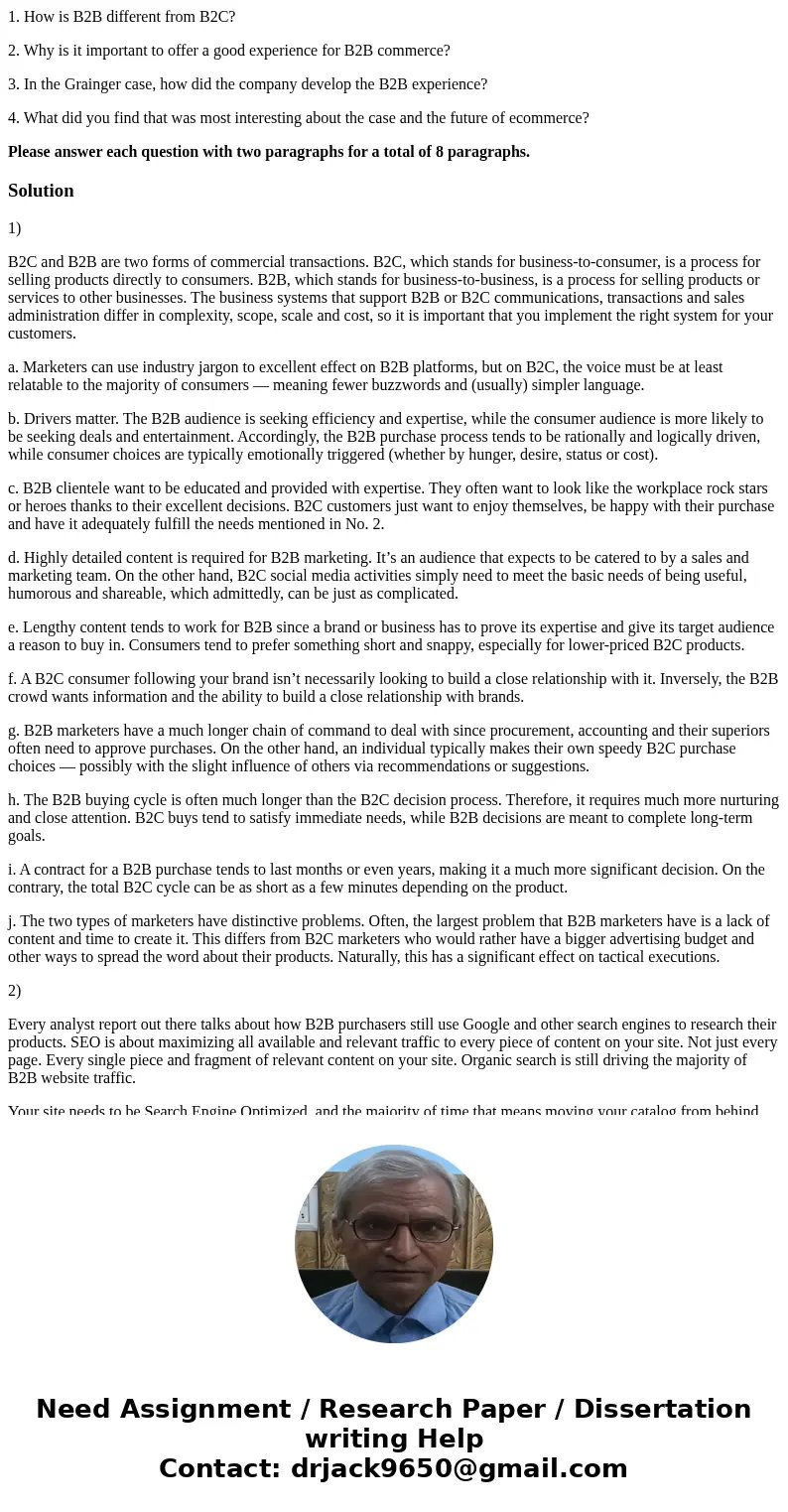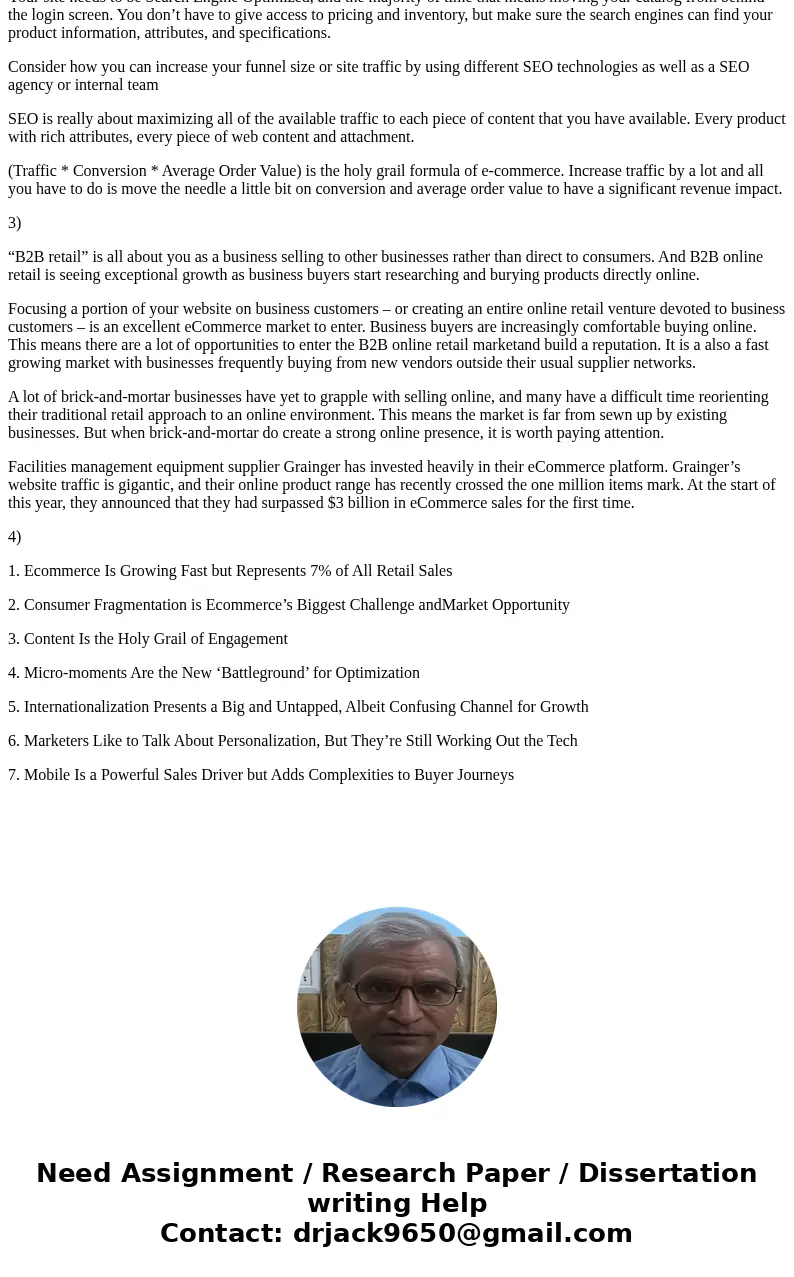1 How is B2B different from B2C 2 Why is it important to off
1. How is B2B different from B2C?
2. Why is it important to offer a good experience for B2B commerce?
3. In the Grainger case, how did the company develop the B2B experience?
4. What did you find that was most interesting about the case and the future of ecommerce?
Please answer each question with two paragraphs for a total of 8 paragraphs.
Solution
1)
B2C and B2B are two forms of commercial transactions. B2C, which stands for business-to-consumer, is a process for selling products directly to consumers. B2B, which stands for business-to-business, is a process for selling products or services to other businesses. The business systems that support B2B or B2C communications, transactions and sales administration differ in complexity, scope, scale and cost, so it is important that you implement the right system for your customers.
a. Marketers can use industry jargon to excellent effect on B2B platforms, but on B2C, the voice must be at least relatable to the majority of consumers — meaning fewer buzzwords and (usually) simpler language.
b. Drivers matter. The B2B audience is seeking efficiency and expertise, while the consumer audience is more likely to be seeking deals and entertainment. Accordingly, the B2B purchase process tends to be rationally and logically driven, while consumer choices are typically emotionally triggered (whether by hunger, desire, status or cost).
c. B2B clientele want to be educated and provided with expertise. They often want to look like the workplace rock stars or heroes thanks to their excellent decisions. B2C customers just want to enjoy themselves, be happy with their purchase and have it adequately fulfill the needs mentioned in No. 2.
d. Highly detailed content is required for B2B marketing. It’s an audience that expects to be catered to by a sales and marketing team. On the other hand, B2C social media activities simply need to meet the basic needs of being useful, humorous and shareable, which admittedly, can be just as complicated.
e. Lengthy content tends to work for B2B since a brand or business has to prove its expertise and give its target audience a reason to buy in. Consumers tend to prefer something short and snappy, especially for lower-priced B2C products.
f. A B2C consumer following your brand isn’t necessarily looking to build a close relationship with it. Inversely, the B2B crowd wants information and the ability to build a close relationship with brands.
g. B2B marketers have a much longer chain of command to deal with since procurement, accounting and their superiors often need to approve purchases. On the other hand, an individual typically makes their own speedy B2C purchase choices — possibly with the slight influence of others via recommendations or suggestions.
h. The B2B buying cycle is often much longer than the B2C decision process. Therefore, it requires much more nurturing and close attention. B2C buys tend to satisfy immediate needs, while B2B decisions are meant to complete long-term goals.
i. A contract for a B2B purchase tends to last months or even years, making it a much more significant decision. On the contrary, the total B2C cycle can be as short as a few minutes depending on the product.
j. The two types of marketers have distinctive problems. Often, the largest problem that B2B marketers have is a lack of content and time to create it. This differs from B2C marketers who would rather have a bigger advertising budget and other ways to spread the word about their products. Naturally, this has a significant effect on tactical executions.
2)
Every analyst report out there talks about how B2B purchasers still use Google and other search engines to research their products. SEO is about maximizing all available and relevant traffic to every piece of content on your site. Not just every page. Every single piece and fragment of relevant content on your site. Organic search is still driving the majority of B2B website traffic.
Your site needs to be Search Engine Optimized, and the majority of time that means moving your catalog from behind the login screen. You don’t have to give access to pricing and inventory, but make sure the search engines can find your product information, attributes, and specifications.
Consider how you can increase your funnel size or site traffic by using different SEO technologies as well as a SEO agency or internal team
SEO is really about maximizing all of the available traffic to each piece of content that you have available. Every product with rich attributes, every piece of web content and attachment.
(Traffic * Conversion * Average Order Value) is the holy grail formula of e-commerce. Increase traffic by a lot and all you have to do is move the needle a little bit on conversion and average order value to have a significant revenue impact.
3)
“B2B retail” is all about you as a business selling to other businesses rather than direct to consumers. And B2B online retail is seeing exceptional growth as business buyers start researching and burying products directly online.
Focusing a portion of your website on business customers – or creating an entire online retail venture devoted to business customers – is an excellent eCommerce market to enter. Business buyers are increasingly comfortable buying online. This means there are a lot of opportunities to enter the B2B online retail marketand build a reputation. It is a also a fast growing market with businesses frequently buying from new vendors outside their usual supplier networks.
A lot of brick-and-mortar businesses have yet to grapple with selling online, and many have a difficult time reorienting their traditional retail approach to an online environment. This means the market is far from sewn up by existing businesses. But when brick-and-mortar do create a strong online presence, it is worth paying attention.
Facilities management equipment supplier Grainger has invested heavily in their eCommerce platform. Grainger’s website traffic is gigantic, and their online product range has recently crossed the one million items mark. At the start of this year, they announced that they had surpassed $3 billion in eCommerce sales for the first time.
4)
1. Ecommerce Is Growing Fast but Represents 7% of All Retail Sales
2. Consumer Fragmentation is Ecommerce’s Biggest Challenge andMarket Opportunity
3. Content Is the Holy Grail of Engagement
4. Micro-moments Are the New ‘Battleground’ for Optimization
5. Internationalization Presents a Big and Untapped, Albeit Confusing Channel for Growth
6. Marketers Like to Talk About Personalization, But They’re Still Working Out the Tech
7. Mobile Is a Powerful Sales Driver but Adds Complexities to Buyer Journeys


 Homework Sourse
Homework Sourse